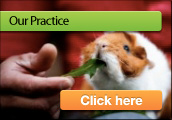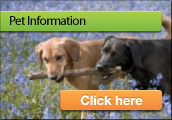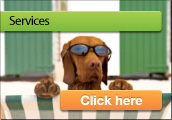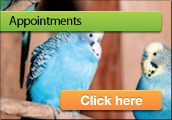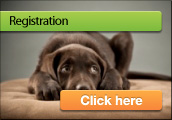Dogs & Puppies
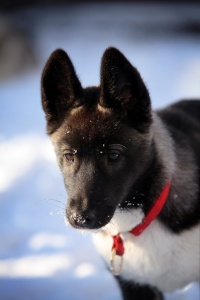
'Whoever said you can’t buy happiness forgot about puppies.' - Gene Hill
Looking After Your Puppy/Dog
It is always a great event when a puppy arrives in its host family. After often several weeks of waiting, the newcomer is here and is the centre of attention.
It is indeed these first weeks of life together which, to a large extent, will set the pattern for your pet´s behaviour in future years.
In particular, you must avoid two big mistakes:
Thinking your puppy is human as far as intellectual and emotional capacities are concerned or, on the contrary, acting as though it were no more than a machine, devoid of feeling and of understanding.
Your dog is a living creature. In their natural environment, dogs live in groups with complex hierarchical social rules. Its development is based on attachment, and the first weeks are crucial for the rest of its life. This is when it learns the basic features of its environment, and how to control itself. The very long period of its dependence on its mother (or human tutors) goes with its considerable learning capacity. It is able to acquire social rituals favouring the harmony of the group and to forge individual bonds with one or other members of it.
For dogs, communication involves all of the senses (sight, smell, taste, hearing and touch). It represents a blend of instinctive messages, reflexes and more complex learned sequences combining posture, vocalisation and emission.
Like all mammals, a dog will adapt- several times in the course of its life, if need be- to very different conditions, families and environments. But do not forget that, whatever the circumstances, your companion is always going to react as a dog, with a dog´s understanding and a dog´s reflexes.
Nor should you forget that your pet is unique- an individual moulded by its parents, birth, early environment, time spent with the mother, and all its various experiences of life.
All of the general rules which you are going to be given here will need to be adapted to each individual case.
Attachment/detachment
Your puppy has no doubt only just left its mother, the primary object of its attachment.
If it is less than 6 months old, then it is going to need someone to replace her. And so it will choose a person who can provide warmth and comfort. It will try to always be as close as possible to this person, whose contact is a source of calm for it. It is vital that this new attachment should be formed, for the pup to be able to set off and discover this new world of yours.
At about the age of 6 months, the time of puberty, you will need to detach your puppy from you- not that this in any way means ceasing to love it! What it means is simply helping it to replace its primary attachment, which was necessary at the beginning, by an attachment to the group as a whole, which will be vital for the rest of its life. For this, what you need to do is to make sure that, in the contacts between you and the little dog, the initiative comes from you and not from the puppy. This will enable it to put up with your being absent. And in this way it will not fall prey to a certain all too common pathology: separation anxiety, causing the dog to howl and ravage or foul the house when you are not there. This pathology is now well known and easy to treat.
Things to Learn
Toilet training
Adopting a little dog means accepting that you are going to be using a floor-mop for a certain time. At the ideal age for adoption- around 8
or 9 weeks- toilet-trained puppies are few and far between!
To help matters there are a few rules to follow and some mistakes to avoid making.
Spot the right moment: in very young pups, each and every meal, drink and awakening triggers the need to "do its business". If you take your dog out right then, you stand a good chance of being able to hand out a bit of reinforcement (strokes) for business done in a place of your choosing.
Reward works better than punishment! It does not need to be systematic in order to be effective.
Never punish your puppy if accidents occur. It might become afraid of you. ‘rubbing your puppies nose in it’ is not a punishment at all (you will see that dogs quite happily do as much by themselves!) and would not help it to understand what you´re so cross about. It will, of course, put on its "hang-dog" look - just as it would if you scolded it when it had done nothing at all! It reacts to your expression rather than to any fault it may have committed itself.
Don´t use the "newspaper method"! Learning twice over is just twice as hard. Take your puppy out, as soon as it has been vaccinated. That way, it will soon learn, and will never be afraid in the street.
Simple commands
If you are going to get on well with your dog, you will need to train it in two types of command: call and stop.
Many a dog has been saved from an accident by being able to obey these very simple commands. In both cases, you should begin training your new friend very early on. Education begins as soon as the puppy arrives in your home.
Use simple words, and always the same ones. "Heel, Fido!" or "Rex, come!" either will work fine, as long as you don’t change them.
The younger the puppy, the more the training needs to be playful, and the shorter the sessions should be: 5 minutes at a stretch for a 3 month-old.
Rewarding is always more effective.
Disobedience is very often due to not understanding. Words mean little to a dog, so you should back them up with clear accompanying gestures which it can learn and interpret more quickly.
As regards the call, never stand in front of your dog pointing at it and calling to heel!
Advice
For the first lessons, crouch, face away and call softly, tapping your thigh, "Come, boy!". This will attract your puppy, who will then come to you, and be delighted to get a vigorous stroking as a reward.
Walking on a lead
Walking on a lead does not mean much to a dog. You are going to have to teach it this new relationship which binds it to its master or mistress.
At first, you could put the collar and lead on your puppy, and let it get used to this little constraint.
When you pull on the lead, do so gently. Give some little tugs, calling your dog´s attention by clicking your tongue. As soon as it follows the direction of the lead, be it only for a yard or so, reward it with some vigorous strokes.
Once the puppy begins to walk alongside you on its lead, go on catching its attention with lots of little sound signals, so as to get it used to making regular visual contact with you. In this way, the physical leash is backed up by a vocal tether.
Keep the lead slack: as soon as the puppy pulls, bring it back sharply to heel and slacken the lead straight away again, accompanying your gesture with always the same command: "Spot, here!" or "Flash, heel!" As soon as the dog goes a few yards without tugging, give it a stroke.
Advice
A tight leash is a transmission line for emotions and may trigger undesirable reactions, such as aggressiveness towards other dogs.
Taking your dog out
While taking all necessary precautions not to expose it to pointless risks (places soiled by animals you do not know and contact with unvaccinated animals), do walk your dog as soon as possible. In all likelihood, it is going to be spending its daily life in a completely different environment from that in which it was born and spent the first few weeks. To be truly at ease in its world, the puppy needs to encounter it regularly by its 13th week.
By walking your dog you avoid it falling victim to ‘deprivation syndrome’. This all too common behavioural affliction consists of severe difficulty to adapt to urban life and an intense fear of strangers.
Should your dog seem unduly afraid when you first take it out, do not stroke it for reassurance: you would be rewarding, and so reinforcing, its fear! Just act as though nothing is wrong and start a game with it by way of distraction. If this is just too hard and your puppy is unable to respond to you in this way, do not hesitate to talk things over with the Vet.
Hierarchy
Finally, to properly respect your dog´s nature, you should fix its place in a hierarchical structure. You should take on the dominant role yourself, and let your dog enjoy the peace of mind that comes with the submissive role in the pack. The dominant animals are the ones which take charge of the smooth operation of the group, settling the place of each member, their comings and goings and all the rituals of daily life. Therefore, it is not a matter of shouting and hitting, but of exercising an everyday authority which can reassure your dog and ensure a settled place for it.
Feed your dog after you yourself have eaten, and share nothing with it at the table. What to you seems to be an act of friendliness could be seen as a sign of submissiveness (not to mention the nutritional confusion!).
Do not allow your dog to choose a sleeping place which is at a strategic location. Bedrooms, the entrance hall or corridors are thus unsuitable places to put your new little friend´s basket.
If you take care of these two very important points, you will run little risk of your dog developing a hierarchically aggressive behaviour pattern.
While your dog is still a puppy, if it does something it shouldn´t, then respond as its mother would: lift it up firmly by the scruff of its neck and hold it hanging there until it calms down. Once it calms down, put it down and stroke its shoulder (a pacification signal). This sequence, far more than anything else, will teach it that you consider yourself to be the dominant animal in the relationship.
Claude Beata
Veterinary Surgeon
